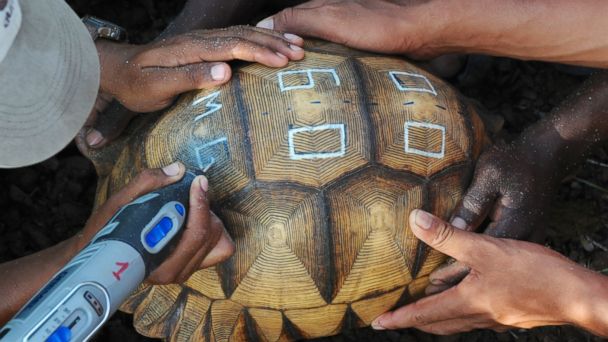Endangered Tortoises Are Being Defaced on Purpose

Credit: Courtesy Turtle Conservancy
Some of the rarest tortoises in the world are a hot commodity on the black market for their unique golden shells which can sell for tens of thousands of dollars.
In an effort to obstruct poachers, conservationists have made the bold move to carve into the shells of the tortoises, protecting the animals by making their domes less attractive. The branded shells also make it easier for authorities to trace them if they are stolen.
"Endangered tortoises and turtles are facing a real threat, and we're hoping that this will be an effective tool to keep them safe," Eric Goode, the founder and president of the Turtle Conservancy told ABC News today.
Years of hunting have caused near extinction for many tortoise species, so sanctuaries and zoos are using identification marks, including laser inscribing, tattoos and engraving to hinder poachers and discourage collectors from paying a great deal of money for the animals.
Since the conservancy began putting the branded tortoises back into the wild in 2011, the shells have not come up in the black market, which officials believe is a good sign.
The Turtle Conservancy's Behler Chelonian Center in Ventura County, Calif., has been working with ploughshare tortoises among others which originate from Madagascar. Their goal is to engrave the shells of both the ploughshares in captivity as well as those living in the wild.
"Because there are so few of them left, no one really knows how many are in the wild," said Goode. "We estimate that there are between 100 to 300 [tortoises] and that they only occupy about 10 square miles."
Some of the endangered tortoises can sell on the black market for upwards of $40,000, so they are considered a gold mine for those who find them.
"Engraving their shells is not dissimilar to cutting off a rhino horn to make them less attractive to poachers," said Goode.
The process of engraving on turtle and tortoise shells can sometimes hurt the animal so the researchers at the Turtle Conservancy work hard to engrave as superficially as possible. Goode described the process like pressing on a fingernail.
"It probably doesn't feel comfortable for [the tortoises], but we don't drill deeper than the keratin layer of the shell," said Dr. Paul Gibbons, the Managing Director of the Turtle Conservancy's Behler Chelonian Center. "As long as we don't hit the bone of the shell beneath the keratin layer, the tortoise is okay. I believe the period of discomfort is worth it to save the animal's life."
Turtles and tortoises predate dinosaurs, having lived on planet Earth for over 250 million years. However, they are slow, passive animals and not the best at evading hunters and poachers.
"These reptiles are survivors, but they are helpless to some extent. It's our job to work to protect them and we are doing everything we can to keep them safe from poachers," said Goode.